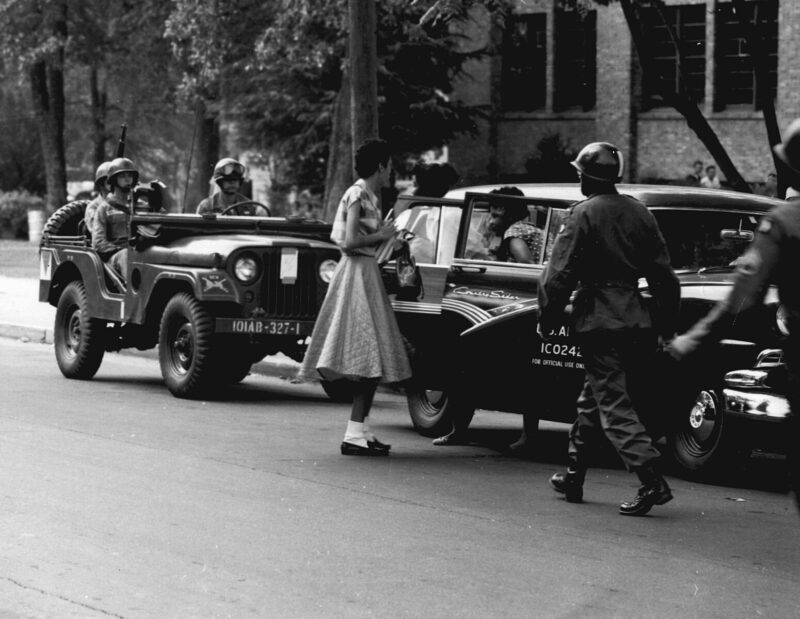The 70th anniversary of the Brown v. Board of Education decision is May 17, 2024. Brown was the Supreme Court Case that ruled that racial segregation or “separate but equal” schools were unconstitutional. But that doesn’t mean that segregation is over. A new report from Stanford University and the University of Southern California shows that, in the largest 100 school districts, segregation between white and Black students has increased 64% since 1988. Segregation by economic status has increased by 50% since 1991.

We have come a long way since the Little Rock Nine desegregated Little Rock High School in 1957, but this report shows that we have a long way to go.
Key Findings
The report found that:
- While not at pre-Brown levels, school segregation is increasing.
- White-Hispanic and white-Asian segregation has also increased, more than doubling in large school districts since the 1980s.
- School segregation is strongly associated with achievement gaps.
Why?
In short, policy choices.
Since 1991, two-thirds of districts that were under court-ordered desegregation orders have been released from those orders. As a result, school districts may not have continued policies that reduced segregation, like voluntary integration and socioeconomic-based student assignment.
Since 1998, the number of charter schools has increased, and where charter schools expanded fastest, segregation grew the most.
When we asked teachers in the We Are Teachers HELPLINE on Facebook their thoughts on why segregation was increasing in schools, here’s what they had to say:
“Segregation in schools happens because we haven’t eliminated the policies that lead to de facto segregation in our communities … school funding should not be tied to local property taxes.” – Cory D.
“As long as there is an option for rich families (predominately white but not necessarily) to pay to go to a private school, public schools will never truly be unsegregated.” – Dan L.
Check out the Segregation Explorer tool from the Educational Opportunity Project at Stanford to see what is happening with school segregation in your state or school.
Now what? Teachers weigh in …
Teachers in the We Are Teachers HELPLINE had ideas on what to do to reverse this trend.
“Filter more funding into schools in underserved communities. … The schools that have been traditionally underfunded should be the best buildings, technology, etc. Further, teachers who teach in those schools should be paid more. They should have smaller classes. Everyone should be trained in culturally responsive teaching. That would draw more privileged students back to those schools.” – Angie R.
“Funding needs to be revamped nationwide.” – Amber B.
“Agree with smaller class sizes, better funding and more high-quality training for teachers.” – Lisa W.
“You’d need to reverse the cause of it and you’re nowhere near doing that.” – William W.
“Mix up district boundaries to include a variety of environments, classes, races, and spread the money equally.” – Faith J.
“Old-fashioned bussing or rezone school boundaries. Neighborhood schools create segregated schools.” – Annette H.
“Eliminating poverty [like Sweden has by equalizing money through taxation] is the only just thing to do. And it is the only thing that will desegregate our communities and our schools.” – Molly B.
OK, so what can teachers do?
If you work in a segregated school, you’re not in charge of housing policies, charter school applications, or parental decisions about where they send kids to school, but there are things that we can do in the classroom to focus on and celebrate diversity.
Understand why school integration is important
“I love the school at which I work in that our school has a very diverse population. … I wish the adults in the world could see how differences can be a beautiful thing … if middle schoolers are able to come together to accomplish goals, shouldn’t adults be able to do the same?” – Christy C.
Diversity in schools is not just about civil rights (though that is important). More than 50 years of research on desegregation efforts has shown that when schools are more diverse, there is no loss of learning for white students and there are gains for students from underrepresented groups. These gains extend to college and job success for students of color, and all students learn how to succeed and work in a diverse community. One thing all teachers can do is advocate for models of desegregation, like magnet schools, and for changes in local policies.
Read more: 6 Things the Nation’s Top-Performing Public School System Does Differently (including integration)
Engage in culturally responsive teaching
“Teach accurate history and culturally relevant literature in the classroom.” – MeGhana L.
The idea behind culturally responsive teaching is that kids connect best, and learn best, from material they connect with. So, teachers can incorporate their students’ experiences, cultures, communication styles, and perspectives into learning. This means being aware of the materials that we’re using and bringing into the classroom, and working to incorporate underrepresented perspectives and topics that are relevant for students.
Learn more: What is culturally responsive teaching?
Learn more: Why and how one teacher created her own culturally responsive materials
Use technology
Technology can connect schools with other schools around the country. Classrooms can participate in activities together via videoconferencing, for example. Also check out these virtual field trips that students can take advantage of to learn about other people and cultures.
Connect learning to life
Teach beyond the next assessment to prepare students to think about real-world issues and topics. Help students understand the context for issues that are important to them, whether that’s an environmental topic like how water resources impact their community or a social justice topic like police actions in a community.
Learn more: 20 #OwnVoices books for the classroom
Explore other aspects of diversity
Beyond International Day or celebrations about food and clothing, even segregated spaces can explore diversity within individuals. A school or class election is a great place to start engaging in thinking about how we are all unique and have diversity of thought.
Read more: 26 Books About Activism and Speaking Up for Young Readers
